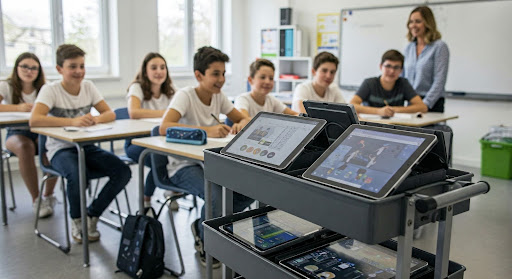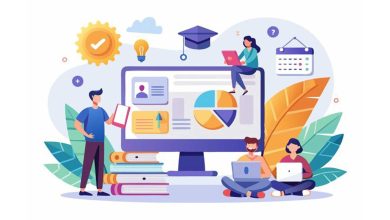
Is your school’s classrooms device-ready ? Schools now give nine out of every ten U.S. students a personal device, but who makes sure those tablets and laptops actually work when class starts? That question has haunted district technology teams since the pandemic triggered an historic shift to one-to-one computing. By March 2021, 90 percent of educators reported at least one school-issued device for every middle- and high-school student, and nearly as many said the same for elementary grades. In theory that device boom should enrich learning; in practice it has multiplied the hours teachers and IT coordinators spend wrestling with log-ins, missing apps, and expired licenses just to get a lesson underway.
Those growing pains come as education leaders brace for a paradox: global ed-tech spending is projected to surge by USD 170.8 billion between 2025 and 2029, yet most K-12 technology chiefs expect tighter operating budgets and smaller support teams. “Every minute an administrator spends side-loading apps onto tablets is a minute stolen from instruction, and from already stretched payrolls,” says Sai Kiran Vudutala, an Atlanta-based staff engineer at a major enterprise endpoint-management firm, who remembers watching that bottleneck hit home.
An Atlanta engineer who felt the pain first-hand
“Teachers loved the idea of digital field trips,” he recalls, “but half the period was gone before every iPad had the right map app.” Determined to strip out that friction, he filed what became a system for configuring and managing classroom devices, in early 2021 .
His patent is deceptively simple. Instead of treating each tablet or laptop as a standalone headache, Vudutala’s design lets an administrator corral hundreds of devices into virtual “carts”, digital bins that can be dragged and dropped onto a class roster through a clean web console. One click assigns a cart to seventh-period biology; another click layers on the apps Miss Tran needs for her frog-dissection module. Behind that interface, a management server pushes the software, stages licenses only where they are needed, and confirms everything before homeroom .
Why the small details matter
Vudutala argues that the breakthrough is less about flashy AI and more about respecting the grind of school operations. “We didn’t invent tablets,” he says. “We made tablets predictable.” The patent’s claim set includes three pieces that make that possible:
- Cart abstraction. Administrators manage groups, not serial numbers, avoiding the spreadsheet maze that often derails deployments .
- Context-aware licensing. The server allocates or withholds licenses in real time, preventing expensive over-assignment
- Staging before class. Apps download silently when devices are idle, so bandwidth spikes never hijack live instruction Exhibit B.1- Patent.
Each feature tackles a pain point documented in the patent’s own background section, which notes that “setup complexities have prevented wide-scale technology adoption” and left teachers “distracted from educating”. By baking those lessons into the workflow, Vudutala’s system turns device management into a background service, much like plumbing or electricity, rather than a daily crisis.
Community dividends beyond convenience
Eliminating that friction pays social dividends. When devices are ready on demand, schools are less tempted to lock them in closets for “special projects,” a practice that disproportionately limits access for low-income students. And because the server records real-time license usage, districts avoid buying redundant app seats, stretching thin funds further.
The platform’s equity upside also impressed educators who reviewed the pilot data. “If a sixth-grader in a low-resource neighborhood can grab any tablet from the cart and find the same tools their peers have in wealthier zip codes, that’s a big step toward digital parity,” one particular educator based in Atlanta noted. It is estimated that the app-savings alone, about $5,000 annually for a school, could cover two refurbished laptops for the special-education department.
A model that tracks with industry headwinds
Analysts say such efficiency plays will define the next ed-tech wave. Even as venture dollars pour into immersive content and adaptive assessment, districts report that the top barrier to adoption is still “time and staffing to support devices,” ahead of pure cost concerns. Solutions that compress setup work without forcing new hardware purchases are therefore poised to scale quickly.
Because Vudutala developed his patent around a vendor-neutral protocol, any device with a lightweight agent can enroll, small charter networks and sprawling suburban districts can implement it without ripping out existing fleets. That interoperability also hints at uses beyond K-12. Hospital training labs and community colleges sure can adapt the cart model to manage VR headsets and nursing-simulation tablets.
Looking ahead
Vudutala sees the next decade of ed-tech device management as a three-front challenge: lifecycle, learning analytics, and equity “Centralizing deployment was the easy win,” he says. “Now we have to keep millions of aging devices secure, updated, and out of landfills, without breaking district budgets.”
A 2024 Education Week analysis warns that pandemic-era Chromebooks are already nearing end-of-life, with many at risk of ending up in local waste streams if districts can’t afford refurbishing or extended updates. Vudutala argues that dashboards must start tracking battery health, OS support windows, and recycling options as rigorously as app licenses, so schools can plan refresh cycles responsibly.
The second frontier is responsible AI. The Consortium for School Networking’s 2025 report lists generative AI as the year’s top “tech enabler” but flags data-privacy gaps and staffing strains as persistent hurdles. Vudutala believes device-management platforms will soon need policy engines that throttle or sandbox AI tools based on district risk rules rather than one-size-fits-all settings. “If AI can personalize reading practice, great, but the same agent shouldn’t siphon student voice data to an external cloud,” he notes.
Finally, he points to unfinished equity work. Surveys show 70 percent of district leaders now view AI and personalized learning as priorities, yet broadband deserts still block many rural classrooms from using even basic cloud dashboards DATIA K12. Vudutala is optimistic that federal BEAD investments and lighter-weight edge agents will let “every school, from downtown Atlanta to the most remote county line, spin up carts in minutes, not months.”
He sums up the outlook this way: “Five years ago we fought to get the right apps onto the right tablets. Five years from now, the bigger victory will be ensuring every learner actually benefits, sustainably, privately, and on day one.”



